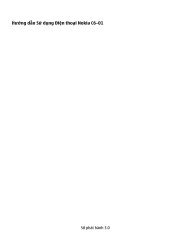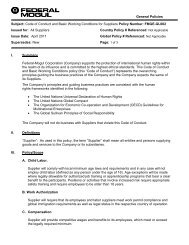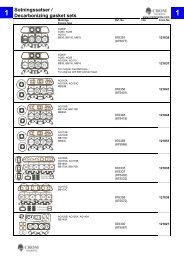Create successful ePaper yourself
Turn your PDF publications into a flip-book with our unique Google optimized e-Paper software.
Heat Dissipation<br />
The heat dissipation rate of a bearing system is affected by many<br />
factors, and the modes of heat transfer need to be considered.<br />
Major heat transfer modes in most systems are conduction through<br />
the housing walls, convection at the inside and outside surfaces<br />
of the housing, and convection by the circulating lubricant. In<br />
many applications, overall heat dissipation can be divided into two<br />
categories:<br />
• Heat removed by circulating oil.<br />
• Heat removed through the housing.<br />
Heat Dissipation by Circulating Oil<br />
Heat dissipated by a circulating oil system is:<br />
Q oil = k 5 x x (θ o - θ i)<br />
If a circulating lubricant other than petroleum oil is used, the heat<br />
carried away by that lubricant will be:<br />
Q oil = k 6 x C p x ρ x x (θ o - θ i)<br />
Where:<br />
k 5 = dimensional factor to calculate heat carried<br />
away by a petroleum oil<br />
k 5 = 28 <strong>for</strong> Q oil in W when in L/min and θ in ˚C<br />
k 5 = 0.42 <strong>for</strong> Q oil in Btu/min when in<br />
U.S. pt/min and θ in ˚F<br />
k 6 = dimensional factor to calculate heat carried<br />
away by a circulating fluid<br />
k 6 = 1.67 x 10 -5 <strong>for</strong> Q oil in W<br />
k 6 = 1.67 x 10 -2 <strong>for</strong> Q oil in Btu/min<br />
Q oil = heat dissipation rate of circulating oil W, Btu/min<br />
θ i = oil inlet temperature<br />
˚C, ˚F<br />
θ o = oil outlet temperature<br />
˚C, ˚F<br />
C p = specific heat of lubricant<br />
J/(kg x ˚C),<br />
Btu/(lb x ˚F)<br />
= lubricant flow rate L/min, U.S. pt/min<br />
ρ = lubricant density kg/m 3 , lb/ft 3<br />
If lubricant flow is unrestricted on the outlet side of a bearing, the<br />
flow rate that can freely pass through the bearing depends on<br />
bearing size and internal geometry, direction of oil flow, bearing<br />
speed and lubricant properties.<br />
ENGINEERING<br />
A tapered roller bearing has a natural tendency to pump oil from<br />
the small end to the large end of the rollers. For maximum oil flow<br />
and heat dissipation, the oil inlet should be adjacent to the small<br />
end of the rollers.<br />
In a splash or oil level lubrication system, heat will be carried by<br />
convection to the inner walls of the housing. The heat dissipation<br />
rate with this lubrication method can be enhanced by using cooling<br />
coils in the housing sump.<br />
Heat Dissipation Through Housing<br />
Heat removed through the housing is, in most cases, difficult to<br />
determine analytically. If the steady-state bearing temperature is<br />
known <strong>for</strong> one operating condition, the following method can be<br />
used to estimate the housing heat dissipation rate.<br />
At the steady-state temperature, the total heat dissipation rate<br />
from the bearing must equal the heat generation rate of the<br />
bearing. The difference between the heat generation rate and heat<br />
dissipation rate of the oil is the heat dissipation rate of the housing at<br />
the known temperature.<br />
Heat losses from housings are primarily by conduction and<br />
convection and are there<strong>for</strong>e nearly linearly related to temperature<br />
difference. Thus, the housing heat dissipation rate is:<br />
Q hsg = C (θ o - θ ambt)<br />
At the operating condition where the steady-state temperature is<br />
known, the housing heat dissipation factor can be estimated as:<br />
C = Q gen - Q oil<br />
θ o - θ ambt<br />
A<br />
TIMKEN MACHINE TOOL CATALOG 65







